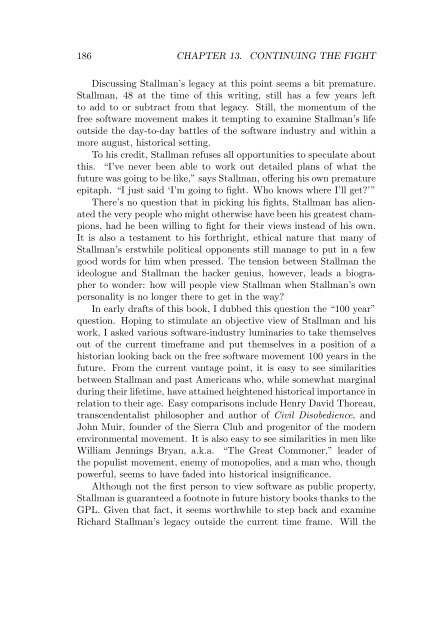Create successful ePaper yourself
Turn your PDF publications into a flip-book with our unique Google optimized e-Paper software.
186 CHAPTER 13. CONTINUING THE FIGHT<br />
Discussing Stallman’s legacy at this point seems a bit premature.<br />
Stallman, 48 at the time of this writing, still has a few years left<br />
to add to or subtract from that legacy. Still, the momentum of the<br />
free software movement makes it tempting to examine Stallman’s life<br />
outside the day-to-day battles of the software industry and within a<br />
more august, historical setting.<br />
To his credit, Stallman refuses all opportunities to speculate about<br />
this. “I’ve never been able to work out detailed plans of what the<br />
future was going to be like,” says Stallman, offering his own premature<br />
epitaph. “I just said ‘I’m going to fight. Who knows where I’ll get?’”<br />
There’s no question that in picking his fights, Stallman has alienated<br />
the very people who might otherwise have been his greatest champions,<br />
had he been willing to fight for their views instead of his own.<br />
It is also a testament to his forthright, ethical nature that many of<br />
Stallman’s erstwhile political opponents still manage to put in a few<br />
good words for him when pressed. The tension between Stallman the<br />
ideologue and Stallman the hacker genius, however, leads a biographer<br />
to wonder: how will people view Stallman when Stallman’s own<br />
personality is no longer there to get in the way?<br />
In early drafts of this book, I dubbed this question the “100 year”<br />
question. Hoping to stimulate an objective view of Stallman and his<br />
work, I asked various software-industry luminaries to take themselves<br />
out of the current timeframe and put themselves in a position of a<br />
historian looking back on the free software movement 100 years in the<br />
future. From the current vantage point, it is easy to see similarities<br />
between Stallman and past Americans who, while somewhat marginal<br />
during their lifetime, have attained heightened historical importance in<br />
relation to their age. Easy comparisons include Henry David Thoreau,<br />
transcendentalist philosopher and author of Civil Disobedience, and<br />
John Muir, founder of the Sierra Club and progenitor of the modern<br />
environmental movement. It is also easy to see similarities in men like<br />
William Jennings Bryan, a.k.a. “The Great Commoner,” leader of<br />
the populist movement, enemy of monopolies, and a man who, though<br />
powerful, seems to have faded into historical insignificance.<br />
Although not the first person to view software as public property,<br />
Stallman is guaranteed a footnote in future history books thanks to the<br />
GPL. Given that fact, it seems worthwhile to step back and examine<br />
Richard Stallman’s legacy outside the current time frame. Will the


